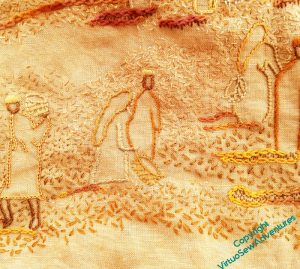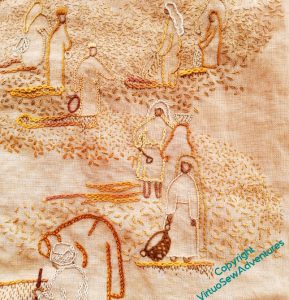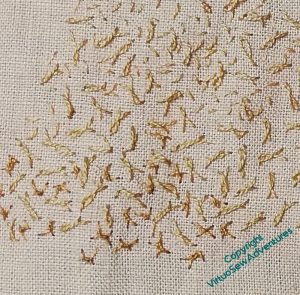The Excavation – dust in the air
There’s a great deal of stitching still to do on the Excavation. I’ve not tackled the large title because my hoops are in the loft and I’ve not got them down yet, but in any case, adding texture across the piece to help the figures to pop out a little more is taking quite a lot of work. The seed stitches in the distance and around head height help to create the impression of dust in the air – much more effectively, in fact, than I could ever have hoped. Adding the very lightest cream stitches has made quite a difference, in a subtle sort of way.
The difficulties come as I bring the stitching forward, the figures being closer, but the air still dusty. There are relatively few singleton stitches, and many of them are quite square and “manufactured” in appearance, making the dusty, earthy effect harder to produce.
Here you can see that as I’ve moved closer to the viewer, I’ve moved from seed stitch, to single chain stitches, and now to twisted chain stitches. They are well spaced because I’m intending to flow other stitches around them – seed stitches and single chain stitches, to start with.
You might just be able to see one of my experiments here, although it must be said, good as phone cameras are these days, this picture is rather pushing beyond the limit.
I’ve added at the bottom of the section, in among the twisted single chain stitches, a variation on Danish Knotted Cross Stitch. In the original version, the cross is worked first, and the knot on top of it. That helps in working a regular shape, but I want something more tangled here, so I work one stitch of the cross, and work the knot as part of the second stitch. I’ve found that as I tighten the stitch, I can move the knot a little, and where I place the end of the last leg helps to make the stitch look more ragged.
Whether I like the result or not, I’m not yet sure!




Danish Knot Stitch (sometimes called Detached Palestrina Stitch and sometimes German Knot Stitch) is worked in the way you have done here – the knot is part of the second stitch.
Danish Knotted Cross Stitch is much tidier as you first make the cross, then you knot it.
To make dust and all sorts of flying dirt, the Danish Knot Stitch is better, I think. From a distance, it will indeed look ‘sandy’.
Plenty of variety in those dusty knots. Such small stitches are bound to be very slow to work, so it’s a good thing that you’re getting a range of types to play with, to stop it becoming a chore.
Certainly looking very dusty. I love how you are working all these different stitches together. xx
Love your dust-stitches. They enhance the feeling of action in the image, really drawing one in to the activity depicted. I like the scratchy, sketchy nature of the Danish Knot Stitch – a very good choice.
The ‘dust’ is adding some wonderful depth to the picture.
My family went through the Suez Canal when I was a child and mum and I took the tour the ship laid on to Cairo and the Pyramids. In the dawn just after we left the ship we saw a camel with her young one through the blowing sand that was glowing in the dawn light. This reminds me of that scene.
You are doing so well with this. Having just looked back at some of your earlier pictures where you had just begun with the outlined figures, the seed stitching is adding so much life and depth to the image. You are managing to balance the sense of the land and the dust in the air, no small feat. I was amused, though, when I misread your opening words which told me (erroneously) that your hopes were in the loft! Oh dear I thought, then smiled to myself. I do wonder if hoops might make the seed stitching go slightly more quickly with two free hands.
Hope you have a very fine Christmas with at least some stitchy delights along the way